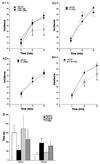Corticotropin-releasing factor in the dorsal raphe nucleus: Linking stress coping and addiction
- PMID: 19800322
- PMCID: PMC2819581
- DOI: 10.1016/j.brainres.2009.09.100
Corticotropin-releasing factor in the dorsal raphe nucleus: Linking stress coping and addiction
Abstract
Addiction and stress are linked at multiple levels. Drug abuse is often initiated as a maladaptive mechanism for coping with stress. It is maintained in part by negative reinforcement to prevent the aversive consequences of stress associated with abstinence. Finally, stress is a major factor leading to relapse in subjects in which drug seeking behavior has extinguished. These associations imply overlapping or converging neural circuits and substrates that underlie the processes of addiction and the expression of the stress response. Here we discuss the major brain serotonin (5-HT) system, the dorsal raphe nucleus (DRN)-5-HT system as a point of convergence that links these processes and how the stress-related neuropeptide, corticotropin-releasing factor (CRF) directs this by a bimodal regulation of DRN neuronal activity. The review begins by describing a structural basis for CRF regulation of the DRN-5-HT system. This is followed by a review of the effects of CRF and stress on DRN function based on electrophysiological and microdialysis studies. The concept that multiple CRF receptor subtypes in the DRN facilitate distinct coping behaviors is reviewed with recent evidence for a unique cellular mechanism by which stress history can determine the type of coping behavior. Finally, work on CRF regulation of the DRN-5-HT system is integrated with literature on the role of 5-HT-dopamine interactions in addiction.
Copyright 2009 Elsevier B.V. All rights reserved.
Figures


References
-
- Amat J, Tamblyn JP, Paul ED, Bland ST, Amat P, Foster AC, Watkins LR, Maier SF. Microinjection of urocortin 2 into the dorsal raphe nucleus activates serotonergic neurons and increases extracellular serotonin in the basolateral amygdala. Neuroscience. 2004;129:509–519. - PubMed
-
- Andrews CM, Lucki I. Effects of cocaine on extracellular dopamine and serotonin levels in the nucleus accumbens. Psychopharmacology (Berl) 2001;155:221–229. - PubMed
-
- Austin MC, Rhodes JL, Lewis DA. Differential distribution of corticotrophin-releasing hormone immunoreactive axons in monoaminergic nuclei of the human brainstem. Neuropsychopharmacology. 1997;17:326–341. - PubMed
-
- Austin MC, Janosky JE, Murphy HA. Increased corticotropin-releasing hormone immunoreactivity in monoamine-containing pontine nuclei of depressed suicide men. Mol. Psychiatry. 2003;8:324–332. - PubMed
-
- Bale TL, Vale WW. CRF and CRF receptors: role in stress responsivity and other behaviors. Annu Rev Pharmacol Toxicol. 2004;44:525–557. - PubMed

